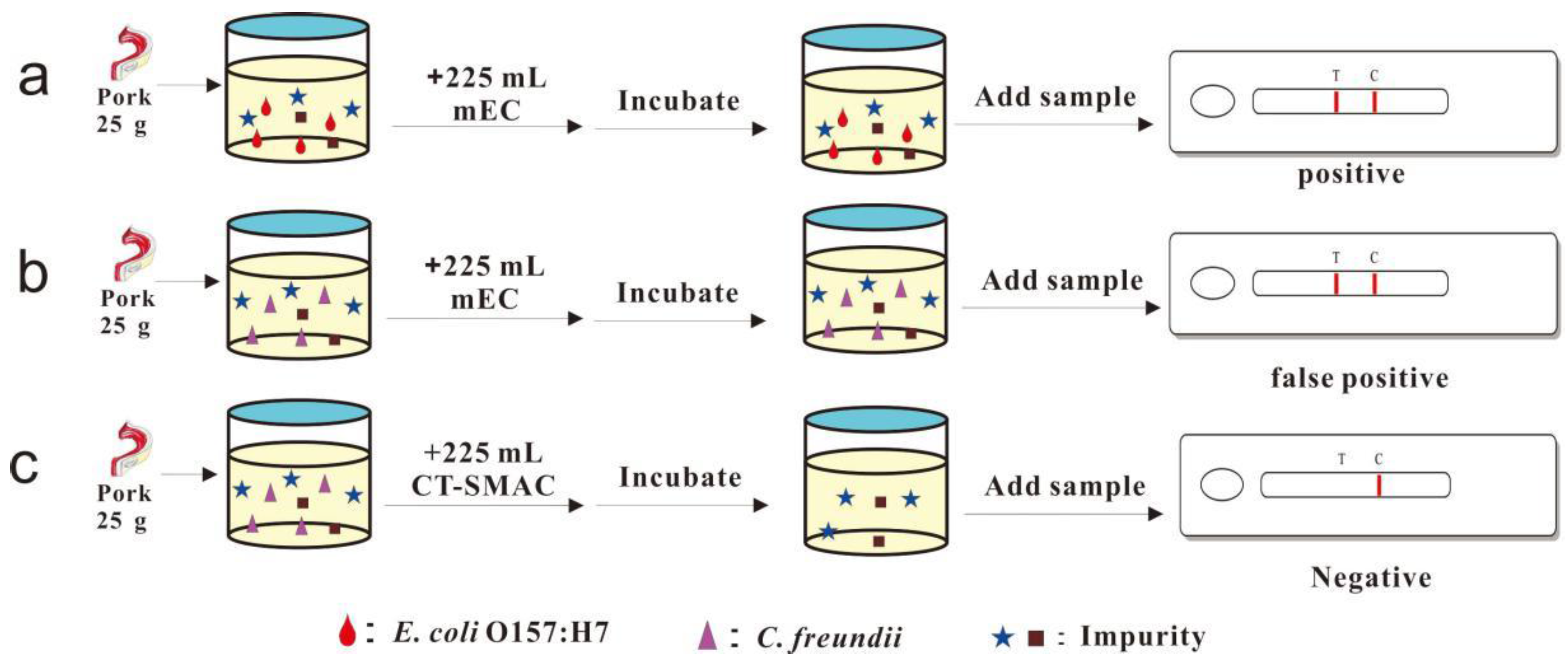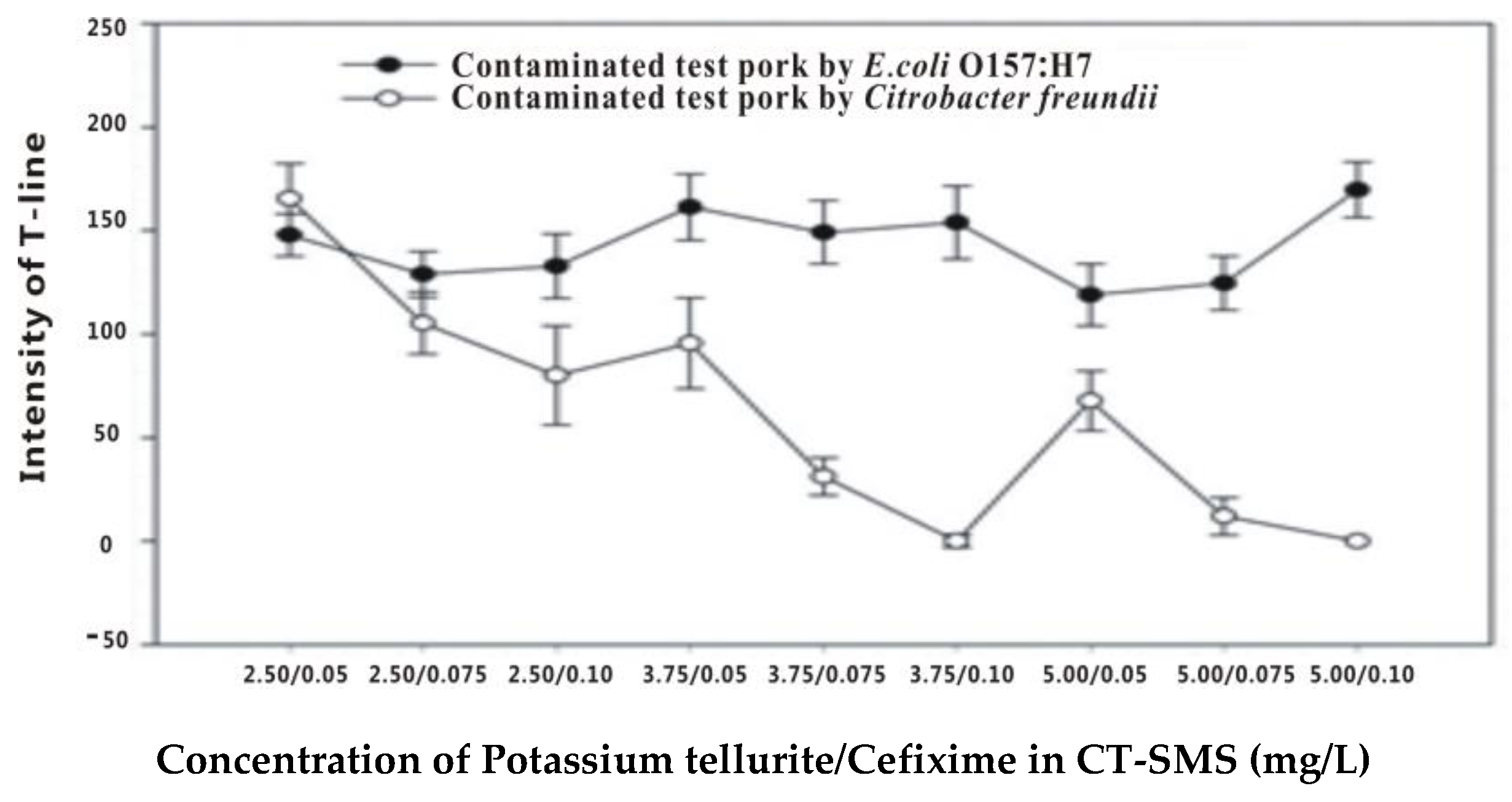Strategy for Accurate Detection of Escherichia coli O157:H7 in Ground Pork Using a Lateral Flow Immunoassay
Abstract
:1. Introduction
2. Materials and Methods
2.1. Materials
2.2. Preparation of Au-LFIA Test Strips
2.3. Pretreatment of Ground Pork Samples
2.4. Enrichment with Modified EC Broth and Evaluation by Using Au-LFIA Test Strip
2.5. Specificity of the Au-LFIA Test Strip
2.6. Identification of the False-Positive Bacterium
2.7. Cross Activity of C. freundii with Au-LFIA Strip
2.8. Optimization of Enrichment Conditions
2.9. Evaluation of the Optimized Enrichment by Using Au-LFIA Test Strip
3. Results and Discussion
3.1. Specificity of the Au-LFIA
3.2. False-Positive Result of Au-LFIA Test Strip
3.3. Isolation and Identification of C. freundii from Incubated Broth
3.4. Cross-Reactivity of C. freundii with Au-LFIA Strip
3.5. Optimization of the Modified Culture Medium for C. freundii Inhibition
3.6. Evaluation of Modified CT-SMAC in Ground Pork Test
4. Conclusions
Supplementary Materials
Acknowledgments
Author Contributions
Conflicts of Interest
References
- Pennington, H. Escherichia coli O157. Lancet 2010, 376, 1428–1435. [Google Scholar] [CrossRef]
- Liu, Y.; Mustapha, A. Detection of viable Escherichia coli O157:H7 in ground beef by propidium monoazide real-time PCR. Int. J. Food Microbial. 2014, 170, 48–54. [Google Scholar] [CrossRef] [PubMed]
- Peng, T.; Zhang, F.S.; Yang, W.C.; Li, D.X.; Chen, Y.; Xiong, Y.H.; Wei, H.; Lai, W.H. Lateral-Flow Assay for Rapid Quantitative Detection of Clorprenaline Residue in Swine Urine. J. Food Prot. 2014, 77, 1824–1829. [Google Scholar] [CrossRef] [PubMed]
- Amani, J.; Ahmadpour, A.; Fooladi, A.A.I.; Nazarian, S. Detection of E. coli O157:H7 and Shigella dysenteriae toxins in clinical samples by PCR-ELISA. Braz. J. Infect. Dis. 2015, 19, 278–284. [Google Scholar] [CrossRef] [PubMed]
- Deng, S.L.; Shan, S.; Xu, C.L.; Liu, D.F.; Xiong, Y.H.; Wei, H.; Lai, W.H. Sample Preincubation Strategy for Sensitive and Quantitative Detection of Clenbuterol in Swine Urine Using a Fluorescent Microsphere–Based Immunochromatographic Assay. J. Food Prot. 2014, 77, 1998–2003. [Google Scholar] [CrossRef] [PubMed]
- Shan, S.; Lai, W.; Xiong, Y.; Wei, H.; Xu, H. Novel strategies to enhance lateral flow immunoassay sensitivity for detecting foodborne pathogens. J. Agric. Food Chem. 2015, 63, 745–753. [Google Scholar] [CrossRef] [PubMed]
- Borrebaeck, C.A. Antibodies in diagnostics–from immunoassays to protein chips. Immunol. Today 2000, 21, 379–382. [Google Scholar] [CrossRef]
- Van Der Veer, J.; Lewis, R.J.; Emtiazjoo, A.M.; Allen, S.D.; Wheat, L.J.; Hage, C.A. Cross-reactivity in the Platelia™ Aspergillus enzyme immunoassay caused by blastomycosis. Med. Mycol. 2012, 50, 396–398. [Google Scholar] [CrossRef] [PubMed]
- Song, C.; Liu, C.; Wu, S.; Li, H.; Guo, H.; Yang, B.; Qiu, S.; Li, J.; Liu, L.; Zeng, H. Development of a lateral flow colloidal gold immunoassay strip for the simultaneous detection of Shigella boydii and Escherichia coli O157: H7 in bread, milk and jelly samples. Food Control 2016, 59, 345–351. [Google Scholar] [CrossRef]
- Cho, I.-H.; Bhunia, A.; Irudayaraj, J. Rapid pathogen detection by lateral-flow immunochromatographic assay with gold nanoparticle-assisted enzyme signal amplification. Int. J. Food Microbiol. 2015, 206, 60–66. [Google Scholar] [CrossRef] [PubMed]
- Xie, Q.-Y.; Wu, Y.-H.; Xiong, Q.-R.; Xu, H.-Y.; Xiong, Y.-H.; Liu, K.; Jin, Y.; Lai, W.-H. Advantages of fluorescent microspheres compared with colloidal gold as a label in immunochromatographic lateral flow assays. Biosens. Bioelectron. 2014, 54, 262–265. [Google Scholar] [CrossRef] [PubMed]
- Cui, X.; Xiong, Q.-R.; Xiong, Y.-H.; Shan, S.; Lai, W.H. Establishing of a method combined immunomagnetic separation with colloidal gold lateral flow assay and its application in rapid detection of Escherichia coli O157:H7. Chin. J. Anal. Chem. 2013, 41, 1812–1816. [Google Scholar] [CrossRef]
- Wang, J.-Y.; Chen, M.-H.; Sheng, Z.-C.; Liu, D.-F.; Wu, S.-S.; Lai, W.-H. Development of colloidal gold immunochromatographic signal-amplifying system for ultrasensitive detection of Escherichia coli O157:H7 in milk. RSC Adv. 2015, 5, 62300–62305. [Google Scholar] [CrossRef]
- Cui, X.; Huang, Y.; Wang, J.; Zhang, L.; Rong, Y.; Lai, W.; Chen, T. A remarkable sensitivity enhancement in a gold nanoparticle-based lateral flow immunoassay for the detection of Escherichia coli O157:H7. RSC Adv. 2015, 5, 45092–45097. [Google Scholar] [CrossRef]
- Chen, M.; Yu, Z.; Liu, D.; Peng, T.; Liu, K.; Wang, S.; Xiong, Y.; Wei, H.; Xu, H.; Lai, W. Dual gold nanoparticle lateflow immunoassay for sensitive detection of Escherichia coli O157:H7. Anal. Chim. Acta 2015, 876, 71–76. [Google Scholar] [CrossRef] [PubMed]
- Sowers, E.G.; Wells, J.G.; Strockbine, N.A. Evaluation of commercial latex reagents for identification of O157 and H7 antigens of Escherichia coli. J. Clin. Microbiol. 1996, 34, 1286–1289. [Google Scholar] [PubMed]
- Navarro, A.; Eslava, C.; de la Torre, G.G.; Leon, L.A.; Licona, D.; Leon, L.; Zarco, L.A.; Cravioto, A. Common epitopes in LPS of different Enterobacteriaceae are associated with an immune response against Escherichia coli O157 in bovine serum samples. J. Med. Microbial. 2007, 56, 1447–1454. [Google Scholar] [CrossRef] [PubMed]
- Bennett, A.R.; Macphee, S.; Betts, R.P. Evaluation of methods for the isolation and detection of Escherichia coli O157 in minced beef. Lett. Appl. Microbiol. 1995, 20, 375. [Google Scholar] [CrossRef] [PubMed]
- Zadik, P.M.; Chapman, P.A.; Siddons, C.A. Use of tellurite for the selection of verocytotoxigenic Escherichia coli O157. J. Med. Microbiol. 1993, 39, 155–158. [Google Scholar] [CrossRef] [PubMed]
- Wang, Y.; Ye, Z.; Si, C.; Ying, Y. Monitoring of Escherichia coli O157:H7 in food samples using lectin based surface plasmon resonance biosensor. Food Chem. 2013, 136, 1303–1308. [Google Scholar] [CrossRef] [PubMed]


| Species | Source | Result (Approx. 105 CFU/mL) |
|---|---|---|
| E. coli O157:H7 | ATCC 43888 | + |
| E. coli O157:H7 | CMCC 44828 | + |
| E. coli O157:H7 | NCTC 12900 | + |
| E. coli O157:H7 | XY0540 a | + |
| E. coli O157:H7 | XY0480 a | + |
| Bacillus cereus | CMCC 63303 | − |
| Bacillus cereus | CMCC 63305 | − |
| Bacillus cereus | SLK a | − |
| Bacillus licheniformis | CMCC 63519 | − |
| Bacillus subtilis | BD366 a | − |
| Candida albicans | ATCC 10231 | − |
| Candida albicans | Z1 a | − |
| Cronobacter cloacae | CMCC 45301 | − |
| Cronobacter sakazakii | CMCC 45401 | − |
| Cronobacter sakazakii | CMCC 45402 | − |
| enteropathogenic E. coli | CMCC 44496 | − |
| E. coli | CMCC 44102 | − |
| E. coli | ATCC 25922 | − |
| Lactobacillus bulgaricus | F1 a | − |
| Listeria grayi | ATCC 25401 | − |
| Listeria innocua | ATCC 33090 | − |
| Listeria innocua | ATCC 11288 | − |
| Listeria ivanovii | ATCC 19119 | − |
| Listeria monocytogenes | ATCC 13932 | − |
| Listeria monocytogenes | CMCC 54001 | − |
| Listeria monocytogenes | CMCC 54007 | − |
| Listeria welshimeri serovar 6b | ATCC 35897 | − |
| Listeria seeligeri | ATCC 35967 | − |
| Micrococcus luteus | CMCC 28001 | − |
| Proteus vulgaris | CMCC 49027 | − |
| Pseudomonas aeruginosa | ATCC 27853 | − |
| Pseudomonas aeruginosa | CMCC 10104 | − |
| Salmonella anatum | ATCC 9270 | − |
| Salmonella choleraesuis | ATCC 13312 | − |
| Salmonella choleraesuis | CICC 21493 | − |
| Salmonella enteritidis | ATCC 13076 | − |
| Salmonella paratyphi A | ATCC 9150 | − |
| Salmonella enterica | ATCC 10708 | − |
| Salmonella typhimurium | ATCC 13311 | − |
| Serratia marcescens | CMCC 41002 | − |
| Shigella flexneri | ATCC 12022 | − |
| Shigella sonnei | CMCC 51592 | − |
| Staphylococcus aureus | CMCC 26001 | − |
| Staphylococcus aureus | CMCC 26003 | − |
| Vibrio parahaemolyticus | CGMCC 1.1997 | − |
| Samples | Negative Result of Au-LFIA | Positive Result of Au-LFIA | |
|---|---|---|---|
| Samples from the slaughterhouse | 10 positive samples | 0 | 20 |
| 10 negative samples | 0 | 20 | |
| Samples from the supermarket | 10 positive samples | 0 | 20 |
| 10 negative samples | 12 | 8 | |
| Pork Samples | CHROmagarTM Plates | Au-LFIA Test Strip | ||
|---|---|---|---|---|
| + | − | + | − | |
| Positive samples (E. coli O157:H7) (n = 20) | 20 | 0 | 20 | 0 |
| Negative samples (C. freundii) (n = 20) | 0 | 20 | 1 | 19 |
© 2017 by the authors. Licensee MDPI, Basel, Switzerland. This article is an open access article distributed under the terms and conditions of the Creative Commons Attribution (CC BY) license (http://creativecommons.org/licenses/by/4.0/).
Share and Cite
Cheng, S.; Chen, M.-h.; Zhang, G.-g.; Yu, Z.-b.; Liu, D.-f.; Xiong, Y.-h.; Wei, H.; Lai, W.-h. Strategy for Accurate Detection of Escherichia coli O157:H7 in Ground Pork Using a Lateral Flow Immunoassay. Sensors 2017, 17, 753. https://doi.org/10.3390/s17040753
Cheng S, Chen M-h, Zhang G-g, Yu Z-b, Liu D-f, Xiong Y-h, Wei H, Lai W-h. Strategy for Accurate Detection of Escherichia coli O157:H7 in Ground Pork Using a Lateral Flow Immunoassay. Sensors. 2017; 17(4):753. https://doi.org/10.3390/s17040753
Chicago/Turabian StyleCheng, Song, Ming-hui Chen, Gang-gang Zhang, Zhi-biao Yu, Dao-feng Liu, Yong-hua Xiong, Hua Wei, and Wei-hua Lai. 2017. "Strategy for Accurate Detection of Escherichia coli O157:H7 in Ground Pork Using a Lateral Flow Immunoassay" Sensors 17, no. 4: 753. https://doi.org/10.3390/s17040753





